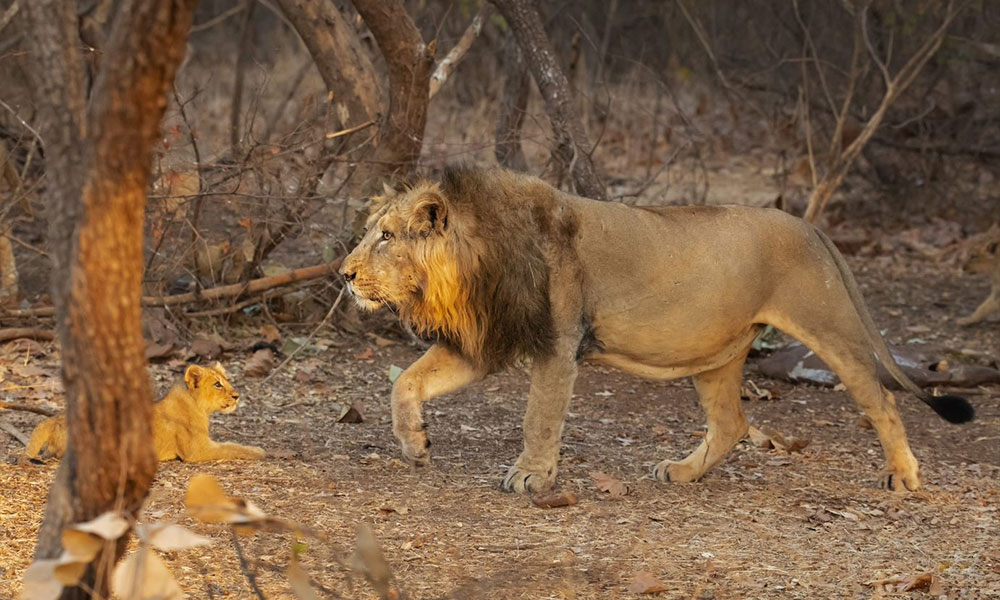The Sasan Gir National Park is also home to another bewitching animal known as Leopard. The sanctuary houses the largest number of leopards in India. In addition, it also represents a diverse ephemeral flora. Some of the common trees include Banyan, Acacia, Teak and the flame of the forest.
The ideal way to explore the jungle and enjoy watching the lions is to attend the 'Lion Shows' which are held by the authorities in the vicinity of the Dewaliya area. However, this show will be replaced by the jungle safaris with a view to increasing the chances of spotting the grandiose creature.
If you want to not miss an opportunity to catch sight of lions, you will need to embark on the distinctive part of the jungle known as the Gir Interpretation Zone. This region covers an area of around four kilometers and is located at a distance of about twelve kilometers from the park headquarters.
In addition to the lions, the park also features a wide range of interesting attractions. There are many fables associated with almost every area of the entire park. There are also a couple of ancient temples in the park including Kankai Mata and Tulsishyam. The park is also popular for shepherds and Madharis. The park is well-known for its hospitable nature and lifestyle.
The best way to get the most out of your trip to the Sasan Gir National Park is by hiring a jeep for a safari ride. It offers an exclusive opportunity to experience close up glances of the wildlife. The most crowd-pleasing safari tours are Sasan-Kamaleshwar Dam, Sasan-Tulsishyam, Sasan Kankai, and Sasan Chhodavdi which offer tourists a chance to catch glimpses of the world's most humongous cats. The best time to visit the park to watch the animals is early in the morning or late in the evening.
When it comes to offering tour packages, India Holiday Mall is the ideal place to go. We are one of the leading travel companies that provide a varied range of tour packages to all the major cities of India that abound with thrilling attractions. With our cost-efficient packages to the best places, you will certainly be able to have a whale of a time on your vacations.
Sasan Gir National Park, also known as Gir Forest National Park, is a famous wildlife sanctuary located in the state of Gujarat, India. It is the last remaining refuge of the Asiatic lions and is dedicated to their conservation. The park was established in 1965 and covers an area of approximately 1,412 square kilometers.
Asiatic Lions: Sasan Gir National Park is renowned for its population of Asiatic lions (Panthera leo persica), which are a critically endangered species. It is the only place in the world where wild Asiatic lions can be found. The park has played a vital role in the conservation of these majestic big cats.
Biodiversity: Besides the Asiatic lions, the park is also home to various other wildlife species, including leopards, spotted deer, sambar deer, chital (spotted deer), wild boars, langurs, and more. It is a paradise for wildlife enthusiasts and photographers.
Birdwatching: Sasan Gir is a haven for birdwatchers as it boasts over 300 species of birds. The park offers excellent opportunities for birdwatching and attracts bird lovers from across the globe.
Jeep Safaris: To explore the wilderness of Sasan Gir National Park and increase the chances of spotting the elusive Asiatic lions, guided jeep safaris are organized by the forest authorities. These safaris offer a thrilling experience while adhering to responsible wildlife tourism practices.
Crocodile Breeding Center: Sasan Gir also houses a Crocodile Breeding Center, where the breeding and conservation of crocodiles are carried out.
Gir Interpretation Zone: This is an enclosed area within the park, where visitors can get a glimpse of the wildlife and familiarize themselves with the flora and fauna without venturing deep into the core sanctuary.
Girnar Mountain: The Girnar Mountain, located near the national park, is a significant pilgrimage site and a popular trekking destination.
It's essential to respect the park's rules and guidelines to ensure the continued conservation of the endangered Asiatic lions and the overall ecosystem. Visitors are advised to maintain a safe distance from the wildlife and refrain from littering to keep the park clean and preserve its natural beauty.
